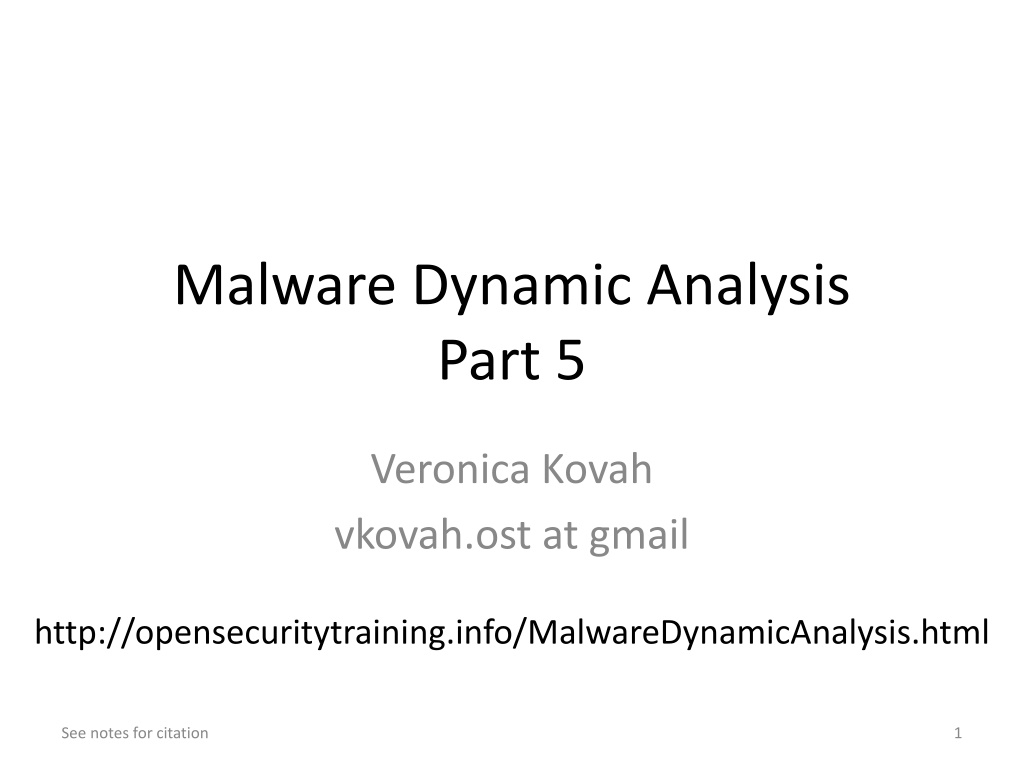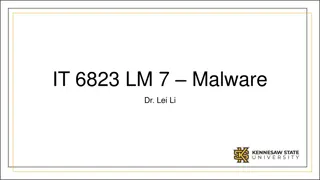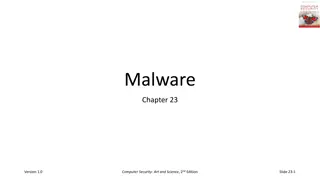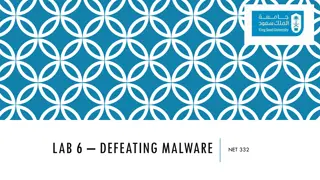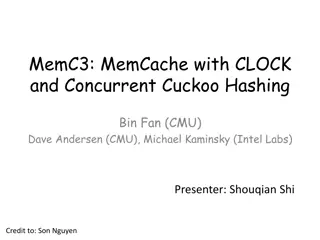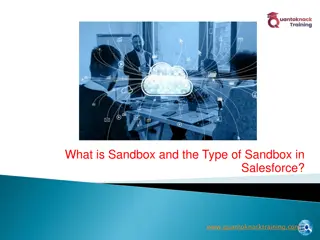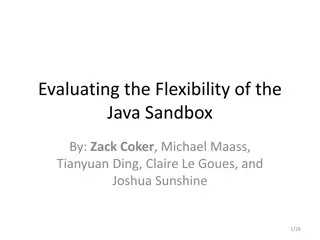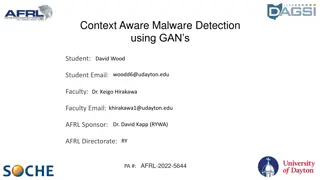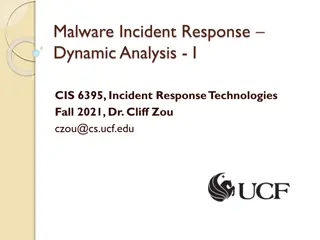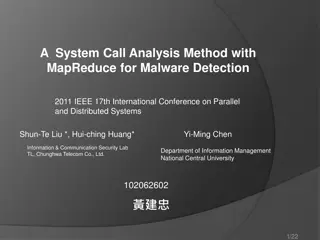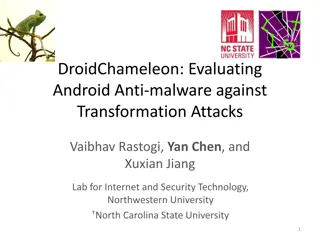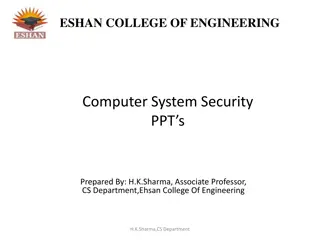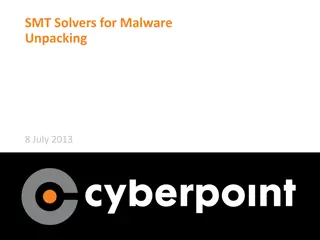Understanding Malware Analysis Using Cuckoo Sandbox
Dive into the world of malware analysis with a focus on using Cuckoo Sandbox, an open-source automated system for analyzing various types of malicious files. Explore the process of setting up, customizing, and running analyses on different malware samples to generate actionable outputs. Learn how to interpret sandbox results and enhance your capability in identifying and combating malware threats effectively.
Download Presentation

Please find below an Image/Link to download the presentation.
The content on the website is provided AS IS for your information and personal use only. It may not be sold, licensed, or shared on other websites without obtaining consent from the author. Download presentation by click this link. If you encounter any issues during the download, it is possible that the publisher has removed the file from their server.
E N D
Presentation Transcript
Malware Dynamic Analysis Part 5 Veronica Kovah vkovah.ost at gmail http://opensecuritytraining.info/MalwareDynamicAnalysis.html See notes for citation 1
All materials is licensed under a Creative Commons Share Alike license http://creativecommons.org/licenses/by-sa/3.0/ See notes for citation 2
Where are we at? Part 5: Using an all-in-one sandbox Cuckoo Sandbox Malware Attribute Enumeration and Characterization (MAEC) Different sandbox results comparison Part 6: Actionable output Yara Snort See notes for citation 3
Malware Analysis Sandbox Provides file system, registry keys, and network traffic monitoring in controlled environment and produces a well formed report Using a sandbox is more efficient and sometimes more effective Configure your own sandbox such as Joebox, GFI Sandbox, and Cuckoo Sandbox. Use public sandbox such as ThreatExpert, GFI ThreatTrack, and Anubis Do not submit malware to a public sandbox if it reveals sensitive information about your organization and/or customer. See notes for citation 4
Cuckoo Sandbox Open source automated malware analysis system Analyzes PE, PDF, MS Office, PHP scripts, etc. Outputs JSON/HTML/MAEC reports Customization Machinery Modules: virtualization software Analysis Package: how to conduct the analysis procedure Processing Modules: how to analyze raw results Signatures Reporting Modules Auxiliary Modules: to be executed in parallel to every analysis See notes for citation 5
Poison Ivy Revert the victimVM to cuckoo snapshot Open three terminals Terminal #1, run inetsim $ sudo inetsim Terminal #2, run Cuckoo Sandbox v1.0 1) $ cd ~/MalwareClass/tools/cuckoo 2) Edit conf/auxiliary.conf (to sniff on vboxnet1) 3) $ python ./cuckoo.py Terminal #3, submit piagent.exe to Cuckoo 1) $ cd ~/MalwareClass/tools/cuckoo/utils 2) $ python ./submit.py~/MalwareClass/samples/PoisonIvy/piagent.exe See notes for citation 6
Cuckoo Sandbox Results Task results are generated under {Cuckoo Root}/storage/analysis/[task number]/ {Cuckoo Root} = ~/MalwareClass/tools/cuckoo reports directory includes reports in different formats logs directory includes raw data named <process id>.bson shots directory includes screen shots files directory includes dropped files. You can then run dropped executables through on their own Submitted sample will be copied to {Cuckoo Root}/storage/binaries/MD5NAME, where MD5NAME is the md5 of the submitted sample A symbolic link (named binary) exists under the task result directory See notes for citation 7
Poison Ivy Results $ cd ~/MalwareClass/tools/cuckoo/storage/analysi s/1/reports $ firefox report.html & $ gedit report.json & $ firefox report.maec-4.0.1.xml & See notes for citation 8
Malware Attribute Enumeration and Characterization (MAEC) a standardized language for encoding and communicating high-fidelity information about malware based upon attributes such as behaviors, artifacts, and attack patterns https://maec.mitre.org/about/index.html A standard is necessary to provide a common way to share malware analysis results among organizations to avoid duplicate, inaccurate work See notes for citation 9
MAEC (2) Supported tools Native: Cuckoo Sandbox Via a translator: Anubis, ThreatTrack, ThreatExpert Would be very useful to search openmalware.org samples based on attributes, could make a new search engine: Ask MAEC! See notes for citation 10
Parite (1) Cuckoo v1.0 We will learn how to interpret a sandbox s results based on what we have learned so far Submit parite sample to Cuckoo Sandbox v1.0 1) $ cd ~/MalwareClass/tools/cuckoo/utils 2) $ python submit.py ~/MalwareClass/samples/parite/malware.exe Kill the cuckoo.py process with ctrl-c once the analysis is done See notes for citation 11
Parite (2) - Cuckoo v0.5 Install Cuckoo Sandbox v0.5 s agent on the victim VM Copy agent.py from the host machine to the victim VM Use WinSCP on the victim VM It s located at ~/Updates/cuckoo/agent/agent.py in the host machine Open a DOS terminal and start the agent C:\python27\python.exe c:\agent.py Make a snapshot with the name cuckoo05 See notes for citation 12
Parite (3) - Cuckoo v0.5 Terminal #2, run Cuckoo Sandbox v0.5 1) $ cd ~/Updates/cuckoo 2) $ python ./cuckoo.py Terminal #3, submit parite sample to Cuckoo 1) $ cd ~/Updates/cuckoo/utils 2) $ python submit.py ~/MalwareClass/samples/parite/malware.exe See notes for citation 13
Parite (4) Consult public sandbox results as well under ~/Updates/public_sandbox_results/parite/ anubis: $ evince ./anubis/report.pdf threatexpert: $ firefox ./threatexpert/report.html threattrack: $ evince ./threattrack/analysis.pdf Q1. (SKIP) Does this drop files with randomized names? Q2. How does it persist? Q3. How does it maneuver? Q4. Does it have self-avoidance? Q5. Does it self-destruct? Q6. Where does it try to connect to? See notes for citation 14
Answers for Parite Lab (1) A2. Created Run registry value HKLM\Software\Microsoft\Windows\CurrentVersi on\RUN\fmsiocps to C:\Windows\fmsiocps.exe Modified AppInit_Dlls registry value HKLM\Software\Microsoft\Windows NT\CurrentVesion\Windows\AppInit_Dlls to fmsiocps.dll See notes for citation 15
Answers for Parite Lab (2) A3. Dll injection via AppInit_Dlls Dll injection using CreateRemoteThread() API OpenProcess (PID=1760) VirtualAllocEx NtWriteVirtualMemory CreateRemoteThread Now you are interested in the process name of PID 1760 :D A4. Yes, mutex Residented is created A5. Yes, the submitted sample file was deleted A6. 192.5.5.241 (per ThreatExpert result) See notes for citation 16
Nitol Consult Parite lab slides for how to submit the sample to both versions of Cuckoo Sandbox and answer the following questions about Nitol: Q1. (SKIP) Does this drop files with randomized names? Q2. How does it persist? Q3. How does it maneuver? Q4. Does it have self-avoidance? Q5. Does it do self-destruction? Q6. Where does it try to connect to? See notes for citation 17
Answers for Nitol (1) A2. 1) Registered an auto-start service HKLM\System\CurrentControlSet\Services\Distrib uijq 2) Created lpk.dll under multiple directories for DLL search order hijacking; this technique also makes the malware persistent A3. DLL search order hijacking (lpk.dll) See notes for citation 18
Answers for Nitol (2) A4. Yes, Distribuijq (per ThreatExpert result) ShimCacheMutex is opened by side effect A5. Yes, it moves itself to C:\DOCUME~1\student\LOCALS~1\Temp\SOFTWARE.LOG A6. tutwl.3322.org Microsoft took down the entire 3322.org (google Operation b70 ) but they came back online after agreeing to clean out malware users See notes for citation 19
IMworm Consult Parite lab slides for how to submit the sample to both versions of Cuckoo Sandbox and answer the following questions about IMworm: Q1. (SKIP) Does this drop files with randomized names? Q2. What's the file's original name? Q3. How does it persist? Q4. Does it have self-avoidance? Q5. Does it do self-destruction? Q6. Where does it try to connect to? See notes for citation 20
Answers for IMworm (1) A2. worm2007.exe A3. Using file system and registry key Created C: \Document and Settings\All Users\Start Menu\Programs\Startup\MSconfig.exe, which is a copy of the malware itself Set registry values HKLM\SOFTWARE\Microsoft\Windows NT\CurrentVersion\Winlogon\Userinit & Shell to C:\Windows\system\lsass.exe, which is a copy of the malware itself See notes for citation 21
Answers for IMworm (2) A4. No apparent mutex ShimCacheMutex is opened by side effect A5. No apparent self-destruction A6. Tried to get http://quicknews.info/YMWorm.exe See notes for citation 22
